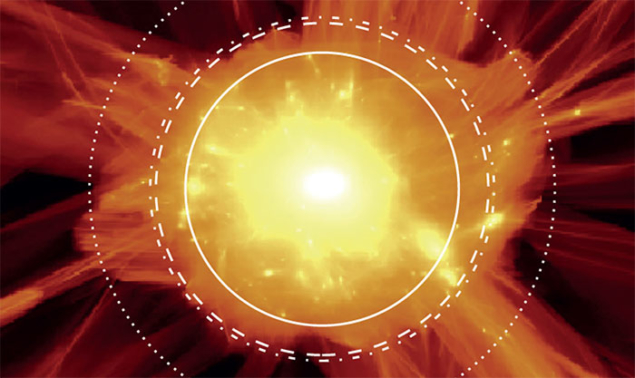
Image credit: ApJ/DOI:10.1088/0004-637X/810/1/36.
Gravitational-lensing measurements indicate that clusters of galaxies are surrounded by large halos of dark matter. By studying the distribution and colour of galaxies inside galaxy clusters using data from the Sloan Digital Sky Survey (SDSS), researchers have now measured a new feature of the shape of these halos. The results show that the density of dark matter in a halo does not gradually fall off with distance, as might be expected, but instead exhibits a sharp edge.
According to the standard cosmological model, dark-matter halos are the result of small perturbations in the density of the early universe. Over time, and under the influence of gravity, these perturbations grew into large dense clumps that affect surrounding matter: galaxies in the vicinity of a halo will initially all move away due to the expansion of the universe, but gravity eventually causes the matter to fall towards and then orbit the halo. Studying the movements of the matter inside halos therefore provides an indirect measurement of the interaction between normal and dark matter, allowing researchers to probe new physics such as dark-matter interactions, dark energy and modifications to gravity.
Using the SDSS galaxy survey, Bhuvnesh Jain and Eric Baxter from the University of Pennsylvania and colleagues at other institutes report new evidence for an edge-like feature in the density profile of galaxies within a halo. The large amount of SDSS data available allowed a joint analysis of thousands of galaxy clusters each containing thousands of galaxies, revealing an edge inside clusters in agreement with simulations based on “splash-back” models. The edge is associated with newly accreted matter which, after falling into the halo, slows down as it reaches the extremity of its elliptical orbit before falling back towards the halo centre. As the matter “splashes back” it slows down, which leads to a build-up of matter at the edge of the halo and a steep fall-off in the amount of matter right outside this radius.
The authors found additional evidence for the edge by studying the colour of the galaxies. Since new stars that formed in hydrogen-rich regions are more bright in the blue part of the spectrum, galaxies with large amounts of new-star formation are more blue than those with little star formation. As a galaxy travels through a cluster, different mechanisms can strip it of the gasses required to form new blue stars, reducing star formation and making the galaxy appear more red. Models therefore predict galaxies still in the process of falling into the halo to be more blue, while those which already passed the edge and are in orbit have started to become red – exactly as data from the SDSS galaxy survey showed.
A range of ongoing and new galaxy surveys – such as Hyper Suprime-Cam, Dark Energy Survey, Kilo-Degree Survey and the Large Synoptic Survey Telescope – will measure the galaxy clusters in more detail. Using additional information on the shape of the clusters, says the team, it is possible to study both the standard physics of how galaxies interact with the cluster and the possible unknown physics of what the nature of dark matter and gravity is.








